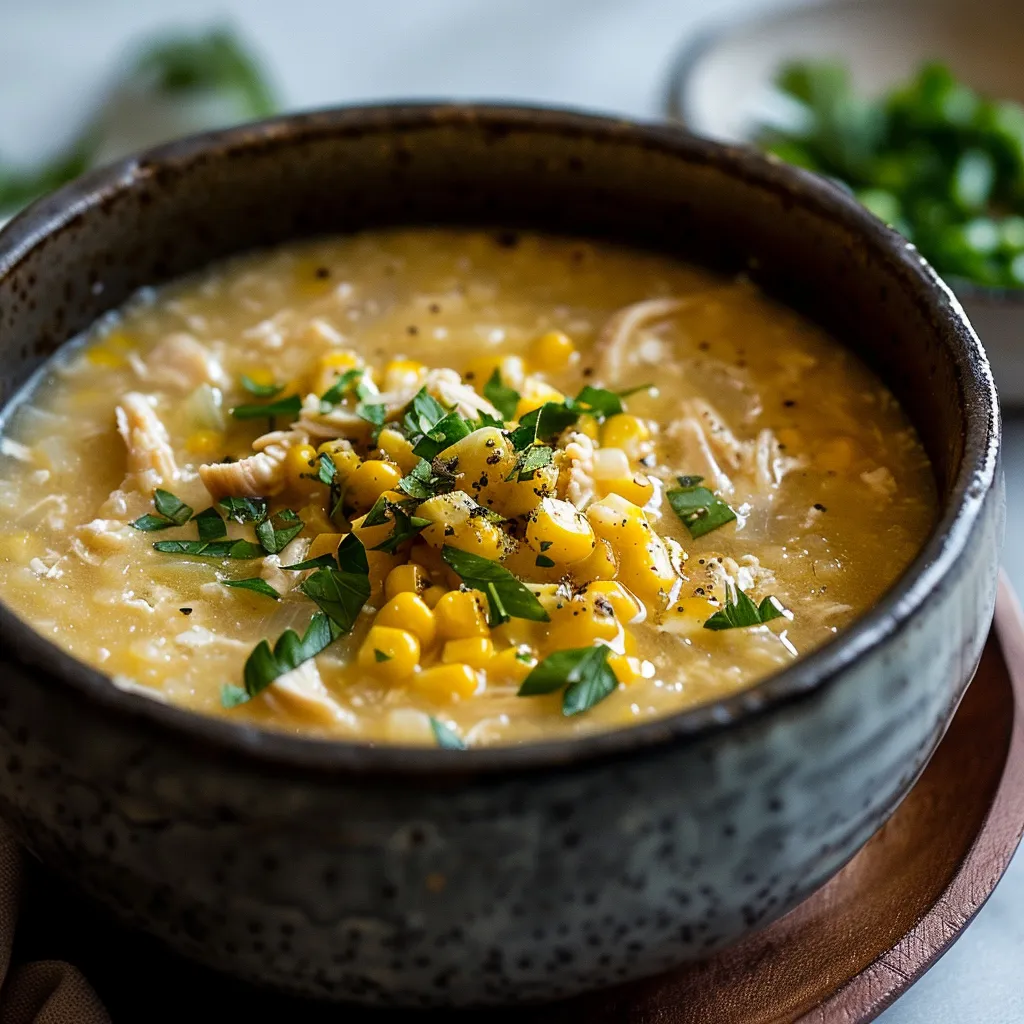 Pin it
Pin it
Chicken corn soup combines the nurturing qualities of classic chicken soup with the sweetness of corn in one comforting bowl. This heartwarming recipe marries silky egg ribbons with tender shredded chicken, creamy corn, and savory broth that soothes both body and spirit. The beauty of this soup lies in its simplicity, requiring just twenty minutes of preparation when using pre cooked chicken, yet delivering complex flavors that feel like a warm hug from the inside out. Perfect for cold evenings, feeling under the weather, or whenever your soul needs comforting.
This recipe holds special significance as my mother's remedy for childhood illnesses. Whenever I felt unwell, this soup would appear alongside her gentle care, creating associations of comfort that remain with me decades later. During my college years, I called home specifically for these instructions after catching my first flu away from family. Now I prepare it for my own household whenever someone feels under the weather, continuing the tradition of edible comfort that spans generations.
Essential Soup Components
- Chicken Stock: Provides savory foundation and nourishing qualities
- Creamed Corn: Creates silky texture and subtle sweetness throughout
- Corn Kernels: Add delightful texture and fresh corn flavor
- Soy Sauce: Introduces umami depth that enhances overall savoriness
- Rice Vinegar: Balances sweetness with gentle acidity
- Sugar: Helps round all flavors into harmonious balance
- Black Pepper: Adds subtle warmth without overwhelming heat
- Sesame Oil: Introduces aromatic richness in the finishing touch
- Shredded Chicken: Provides satisfying protein and familiar comfort
- Cornstarch: Creates perfect consistency without heaviness
- Fresh Eggs: Develop beautiful silky ribbons throughout the broth
Preparation Method
- Stock Flavor Building:
- Begin by selecting a large pot and adding quality chicken stock as your foundation. Pour in creamed corn and additional corn kernels, stirring to combine completely. Add soy sauce, rice vinegar, a small amount of sugar, and freshly ground black pepper to create a balanced flavor profile. Bring this mixture to a gentle simmer over medium heat, allowing ingredients to meld together while releasing their aromas. This initial cooking stage builds the flavor foundation for your entire soup, so quality ingredients truly matter here.
- Perfect Consistency Creation:
- While your broth mixture heats, prepare a cornstarch slurry by whisking cornstarch with cool water in a small bowl until completely smooth with no visible lumps. Once your soup reaches a gentle simmer, slowly pour the slurry into the pot while continuously stirring. The soup will gradually thicken to a silky consistency that coats the back of a spoon but remains pourable. Adjust cornstarch amount for your preferred thickness, understanding that the soup will continue thickening slightly as it cools.
- Egg Ribbon Technique:
- Break fresh eggs into a small bowl and whisk thoroughly until yolks and whites completely combine into a uniform mixture. Using a ladle, create gentle movement in the simmering soup by slowly stirring in a circular motion. While maintaining this movement, pour beaten eggs in a thin, steady stream into the soup. The heat immediately cooks the eggs while the motion creates delicate, silky ribbons throughout the broth. Avoid stirring vigorously which would break the beautiful egg formations into tiny pieces.
- Finishing Touch Application:
- Once egg ribbons have formed, add your shredded chicken to the pot, allowing it to warm through without additional cooking which might toughen the meat. Taste the soup carefully and adjust seasonings if necessary, keeping in mind that the flavors will continue developing as ingredients meld. Just before serving, stir in a small amount of toasted sesame oil, which adds wonderful aroma and depth. This late addition preserves the volatile compounds in sesame oil that would otherwise dissipate during extended cooking.
- Serving Presentation Strategy:
- Ladle the hot soup into prewarmed bowls to maintain proper temperature through enjoying. Sprinkle freshly chopped green onions over each serving for color contrast, texture variation, and bright flavor. For a more substantial meal, add a scoop of freshly cooked white rice to each bowl, allowing it to absorb some of the flavorful broth. This optional addition transforms the soup into a complete one bowl meal perfect for recovery days or when comfort is paramount.
 Pin it
Pin it
My earliest memory of learning to make this soup involved watching my mother demonstrate the egg pouring technique. She emphasized the importance of maintaining a steady hand and consistent pour speed to create beautiful ribbons rather than scrambled eggs. Years later when battling my first adult illness alone, I called her for instructions and felt immediate comfort just hearing her describe the familiar process. When making this for my own family during flu season, I often double the recipe since everyone inevitably requests second bowls.
Alternative Serving Ideas
Transform into meal sized portion by adding cooked rice noodles during final minutes for a delicious corn egg drop noodle soup variation. Create an elegant first course by serving in small porcelain teacups garnished with a single cilantro leaf and a drop of chili oil. Develop a hearty lunch option by serving alongside simple scallion pancakes that provide a satisfying vehicle for scooping up chicken and corn morsels from the broth.
Customization Possibilities
Introduce Sichuan influence by adding a small amount of chili oil and Sichuan peppercorns for a numbing heat experience. Create a herbaceous version by incorporating fresh ginger, garlic, and cilantro stems during the initial simmering stage. Develop a vegetable-forward adaptation by adding baby spinach leaves and sliced mushrooms during the final minutes of cooking.
Storage Solution Tips
Maintain freshness by refrigerating cooled soup in airtight containers where it keeps beautifully for up to three days. Extend shelf life by freezing individual portions in freezer-safe containers for up to two months for emergency comfort food access. Revitalize leftover soup by adding a splash of fresh stock when reheating to restore original consistency and brightness. Consider storing the base soup without eggs, then adding fresh egg ribbons when reheating for optimal texture.
 Pin it
Pin it
Frequently Asked Questions
- → Can I use rotisserie chicken for this soup?
- Absolutely! Rotisserie chicken is perfect for this soup and adds an extra layer of flavor. Simply remove the skin, shred the meat with two forks, and measure out the 1½ cups needed. The dark meat (thighs and legs) adds more flavor, but breast meat works perfectly well too. Rotisserie chicken is especially convenient because it's already seasoned, which complements the soup's flavors. If you have leftover roasted or poached chicken, that works wonderfully as well. In a pinch, you can even use canned chicken—just drain it well and break it up with a fork before adding to the soup.
- → I don't have white pepper. Can I substitute black pepper?
- Yes, you can substitute black pepper for white pepper, but there are some differences to consider. White pepper has a milder, slightly more earthy flavor that's traditional in many Asian soups where a clean appearance is desired. Black pepper has a more pronounced, slightly sharper flavor and will leave visible specks in the soup. If using black pepper, start with about half the amount (¼ teaspoon) and adjust to taste. For the most authentic flavor profile, white pepper is worth adding to your spice collection for this and other Asian-inspired recipes, but black pepper will certainly work in a pinch.
- → What's the best way to create the egg ribbons without getting scrambled eggs?
- Creating those beautiful, delicate egg ribbons takes a little technique, but it's easy once you know the tricks. First, make sure your eggs are thoroughly beaten until no streaks of white remain. The soup should be at a gentle simmer—not a rolling boil, which would break up the eggs too much. Stir the soup in one direction to create a gentle current, and then slowly drizzle the beaten eggs in a thin stream while continuing to stir in the same direction. Pour the eggs from a measuring cup with a spout or use a fork to control the flow. Don't rush this process; it should take 15-20 seconds to add all the eggs. Once added, stir gently just a few more times and then stop—overworking will break the ribbons into tiny pieces.
- → My soup didn't thicken enough. What did I do wrong?
- If your soup didn't reach your desired thickness, there are a few possible causes and easy fixes. First, make sure your cornstarch slurry was properly prepared—cornstarch must be fully dissolved in cold water before adding to hot liquid, and the ratio should be roughly equal parts cornstarch and water. Second, the soup needs to reach a near boil after adding the slurry, as cornstarch activates at high temperatures. If you've already done these steps correctly but still want a thicker soup, you can make additional slurry (start with 1-2 tablespoons cornstarch mixed with equal water) and add it while the soup is simmering. Remember that the soup will continue to thicken slightly as it cools, and reheated leftovers are often thicker than freshly made soup.
- → Is there a way to make this soup ahead of time?
- This soup reheats beautifully, making it perfect for meal prep, but there's a trick to maintaining the best texture. Prepare the soup through adding the chicken and thickening with cornstarch, then cool and refrigerate for up to 3 days. When ready to serve, reheat the soup to a simmer, and then add the beaten eggs fresh at that point. This ensures the egg ribbons maintain their delicate texture. If you've already added the eggs, the soup is still delicious when reheated, but the eggs may break down slightly. Reheat gently on the stovetop rather than in the microwave for the best results. The toasted sesame oil should always be added fresh just before serving, as it loses its aromatic qualities when reheated.
- → Can I make this soup vegetarian or vegan?
- Yes, this soup can be adapted for vegetarian or vegan diets with a few simple swaps. For a vegetarian version, use vegetable broth instead of chicken stock and replace the chicken with extra firm tofu (pressed and diced) or chickpeas. The egg ribbons can remain for a vegetarian version, or be omitted for a vegan adaptation. For a vegan version, you can create a similar egg ribbon effect using a mixture of 3 tablespoons of cornstarch and 1/4 cup plant milk with 1/4 teaspoon turmeric for color, drizzled into the soup using the same technique. Also check that your creamed corn doesn't contain dairy (most commercial brands are vegan). These adaptations maintain the comforting texture and flavor profile while accommodating plant-based diets.
